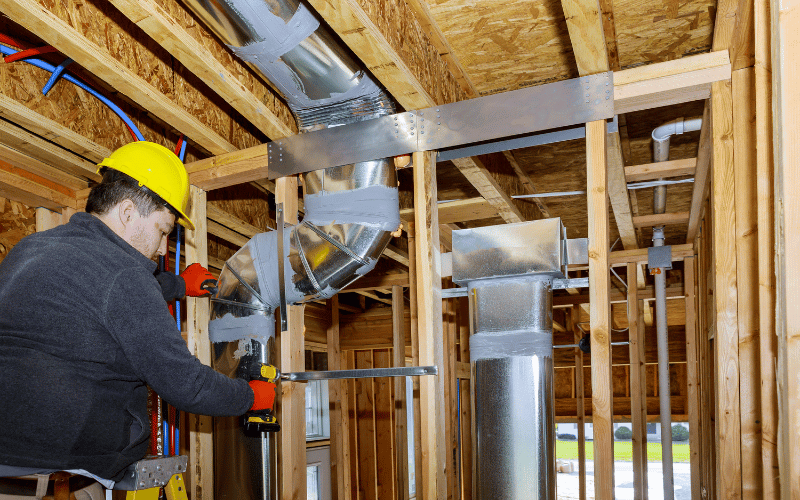In this article, we’ll delve into the significance of correct ductwork installation, the steps to prepare for it, and the best way to install HVAC ductwork. Additionally, we’ll pinpoint common mistakes and emphasize the importance of professional expertise in the installation process.

Install HVAC Ductwork
HVAC systems are essential components of our homes, silently ensuring our comfort. The ductwork, acting much like a network of veins, circulates the conditioned air throughout our living spaces. Properly installing this ductwork is a meticulous task that, when done correctly, guarantees optimal comfort and energy efficiency.
Why Proper Ductwork Installation Matters
Getting your ductwork installed just right means you’ll feel that perfect breeze in every nook and cranny of your home, all while being kind to your wallet with energy savings. Plus, good installation can keep those pesky dust particles and allergens at bay, giving you cleaner air to breathe. And here’s a cherry on top: when your HVAC system is set up properly, it doesn’t have to work as hard, which means it’ll likely stick around longer and cost you less in repairs.
Preliminary Steps Before Installation
Before starting the installation of HVAC ductwork, there are several preliminary steps to consider:
- Assess the Layout: First, assess the layout of your home to determine the best routing for the ductwork. This includes examining the home’s floor plan, considering the location of windows, doors, and walls, and identifying potential obstructions.
- Calculate the Load: Use a load calculation to determine the heating and cooling needs of each room. This informs the size and number of ducts required for optimum efficiency.
- Design the System: Plan the ductwork system, taking into consideration the home’s layout and load calculations. This includes deciding on the type of ductwork material, the size and shape of the ducts, and the routes the ductwork will take.
- Prepare the Tools and Materials: Gather all the necessary tools and materials. This may include fasteners, insulation, and duct tape, among other things.
- Ensure Safety Measures: Before starting the installation, ensure that all safety measures are in place. This means wearing the right protective gear, such as gloves and safety goggles, and ensuring the workspace is well-ventilated.
Best Way To Install HVAC Ductwork
- Proper Sealing: Always ensure that ducts are correctly sealed. Unsealed or poorly sealed ducts can cause conditioned air to escape, reducing the efficiency of the HVAC system.
- Sizing: Ensure the ducts are correctly sized. Too small ducts can overwork your system, while too large ones can reduce air velocity.
- Material Choice: Use appropriate material for your ducts. Flex ducts are easy to install but can be less efficient if not installed properly. Metal ducts are durable but need proper insulation.
- Insulate Ducts: Insulate your ducts properly, especially if they pass through unconditioned spaces like the attic or basement. This prevents heat loss and gains, enhancing energy efficiency.
- Avoid Sharp Turns: Plan your duct routes to avoid sharp turns. Air flows better in straight lines, and sharp turns can slow it down, reducing system efficiency.
- Maintain Balance: Balance your ductwork to ensure even distribution of air throughout the home. Balancing involves adjusting dampers to control the flow of air.
- Regular Maintenance: Regularly maintain your ductwork to keep it in the best condition. This includes cleaning and checking for leaks.
Common Mistakes to Avoid
- Neglecting Airflow: Overlooking the need for proper airflow can lead to a poorly performing HVAC system. It’s crucial to ensure that each room has adequate returns and supplies to maintain optimum airflow.
- Ignoring Load Calculations: Not conducting or ignoring accurate load calculations can result in an inefficient HVAC system. This calculation is crucial for determining the appropriate HVAC size for a particular space.
- Improper Ductwork Design: Incorrect ductwork design can lead to issues like uneven room temperatures and noise. It’s essential to carefully plan and design the ductwork layout to avoid such issues.
- Choosing the Wrong Duct Size: Size plays a significant role in the efficiency of HVAC systems. Too large or too small ducts can significantly impact the performance of the system.
- Poor Insulation: Poor or inadequate insulation allows heat to escape from ducts, which can lead to higher energy bills. Proper insulation helps maintain the desired temperature and improves the energy efficiency of the system.
- Skipping Regular Maintenance: Regular maintenance is crucial for the longevity and efficiency of new HVAC ductwork. Skipping maintenance may lead to decreased performance and increased energy consumption.
Conclusion
Expert ductwork installation is crucial to an efficient, comfortable, and healthy home environment. By observing the best way to install new HVAC ductwork, avoiding common mistakes, and performing regular maintenance, you can boost energy efficiency and prolong your HVAC system’s lifespan. Energy HVAC Services is a reliable authority when it comes to HVAC systems, and they can help you maximize your system’s efficiency while enhancing your health and comfort. Contact us today to ensure proper HVAC ductwork installation.
Frequently Asked Questions
How does an HVAC system impact indoor air quality?
An HVAC system significantly impacts indoor air quality by circulating, filtering, and conditioning the air inside a space.
What are the risks of DIY HVAC repairs versus professional servicing?
DIY HVAC repairs can pose safety risks, including potential electrical hazards or refrigerant exposure. Additionally, untrained repairs can lead to further system damage, inefficiencies, or voided warranties. Professional servicing ensures the system is safely and correctly addressed, maintaining its performance and longevity.
Are ductless AC systems more efficient than traditional ducted systems?
Ductless AC systems, or mini-splits, often boast higher efficiency levels because they eliminate the potential for energy losses through ductwork. Traditional ducted systems can lose up to 30% of the energy, especially if the ducts are in unconditioned spaces. However, the actual efficiency can vary based on system models, maintenance, and installation quality.





